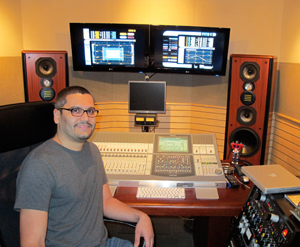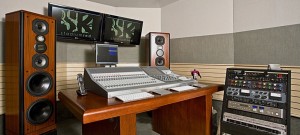Stadium Red Studios Expands II: Mastering Completes the Picture
HARLEM, MANHATTAN: Everything old is new again for Ricardo Gutierrez, the Chief Mastering Engineer at Stadium Red Studios’ new mastering facility. A disciple of the legendary Herb Powers, Gutierrez honed his ears and technical chops at The Hit Factory, where mastering studios and recording facilities worked harmoniously together under one roof.
Now he’s back into that classic workflow, where a record can get tracked, mixed and mastered without leaving the floor. Doing his listening in a new 5.1-ready room designed by Frank Comentale (The Hit Factory, Chung King, Daddy’s House), Gutierrez is more than down with the comprehensive Stadium Red scenario.
“I had been looking for opportunities to set up a studio, but it never felt like the right situation,” he says. “When Claude asked me if I wanted to be on board, I knew the energy was right. We were all of like mind about how we want the music to sound, and how we defined our jobs. The concept is for Stadium Red Studios to be a destination. This is a creative place you can come to and enjoy, but you can also come here and you don’t have to leave. Someone like Just Blaze or Omen can produce here, then record with Tom Lazarus or Ariel Borujow in the live room, and finally master here as well.”
According to Gutierrez, security and enhanced efficiency are solid arguments for having mastering in the house. “A lot of people, especially high-profile artists, don’t want to have to send a file over the Internet, because leaks still happen. People feel 100% more confident in having it mastered in the same place, and we’re not ‘mastering’ in the B-room with plug-ins. We have a dedicated room with an experienced mastering engineer, and that appeals to our clients.
“Another scenario that happens is that an artist starts it in their personal studio, and then they bring it to us for us mixing. Or they record their music in the A-room and mix it at Stadium Red Studios. Now they’re saying, ‘You guys already have the music there, why don’t you master it?’ It’s the end piece of the puzzle.”
Tech heads will take notice of Gutierrez’ uncommon center of operations: a Sony DMX-R100 “Baby Oxford” console that feeds a pair of Legacy Audio speakers and his tight collection of digital/analog processors. “That’s actually what Herb uses,” he says of the classic Sony board. “At first he used a Neve DTC console, 20-bit, but when went back to the Hit Factory, he needed a new digital console and went with a Baby Oxford. As a result, I knew it inside out. It gives me some workflow advantages, and when we switch the room to Surround I’m set up for it.”
The Stadium Red Studios setup is ideal for a mastering engineer who wants to be involved in the creative process, and not just the last stop on the way to iTunes. “The mentality of a typical mastering studio is, ‘These are our hours. We’re opened and closed then, and we don’t go beyond that,’” notes Gutierrez. “But I’m already here in the studio with the mindset that you’re there as late as you need to be. We need to be here so we can listen in on a project in any of the environments here, hear the master back where it’s mixed, and then decide what needs to be tweaked next, if anything.”
— David Weiss
Please note: When you buy products through links on this page, we may earn an affiliate commission.









Mix101
December 16, 2010 at 7:37 pm (13 years ago)“and we’re not ‘mastering’ in the B-room with plug-ins”. I would almost guarantee you are using plugins, it may not be labeled the B-room. With mp3’s,very small budgets for artists and very little time allocated, there really is no alternative. The days of huge out board gear and analog equipment are over. unless it’s indie-rock.